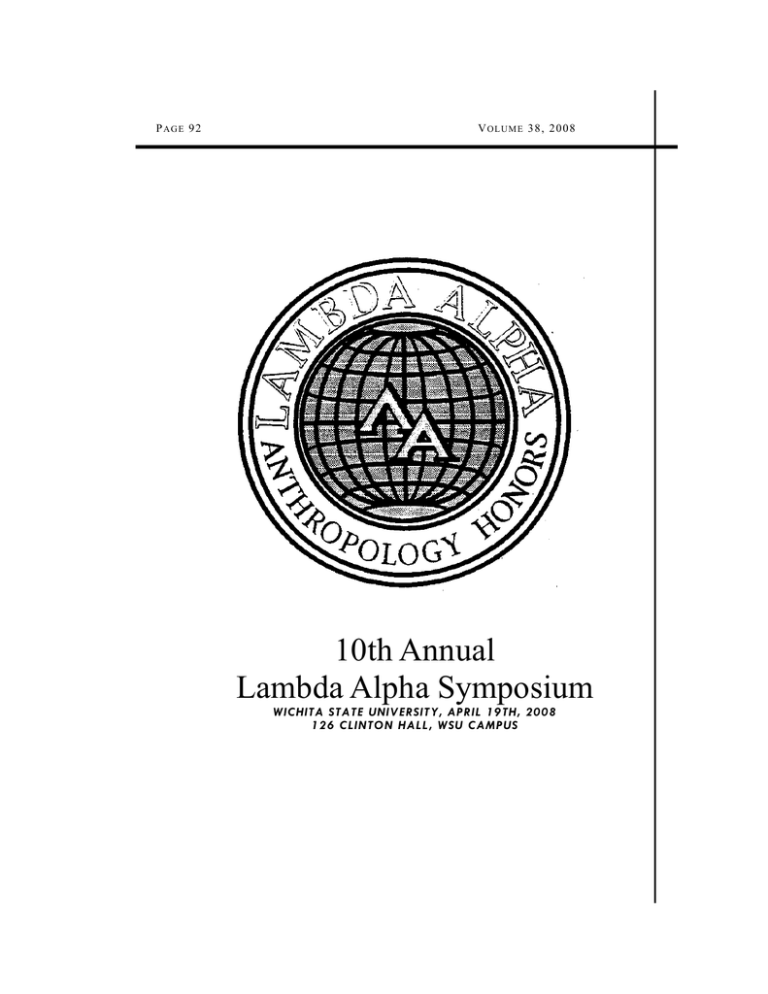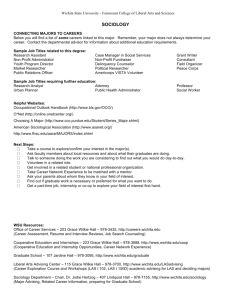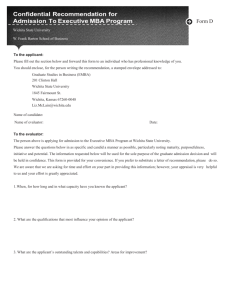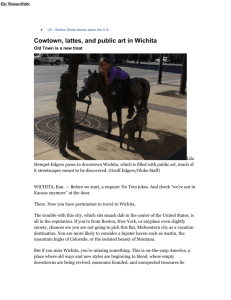10th Annual Lambda Alpha Symposium WICHITA STATE UNIVERSITY, APRIL 19TH, 2008
advertisement

PAGE 92 V O LU M E 3 8 , 2 0 0 8 10th Annual Lambda Alpha Symposium WICHITA STATE UNIVERSITY, APRIL 19TH, 2008 126 CLINTON HALL, WSU CAMPUS L A M B DA A LPH A J O U RN A L PAGE 93 ABSTRACTS Laura Bennett, Wichita State University Determining Burn Patterns Various studies and experiments were carried out to examine to what extent the skeletal remains of a burned body can provide information regarding the origin of a fire and the travel pattern of a fire. A secondary objective of this research project addressed a common conclusion that the human cranium will explode, once subjected to the pressures of high heat. A post-burn examination of the skeletal remains included observation of the burn patterns on the bones and seeks to identify the travel pattern of the fire as it moves across the body. The determination of the direction of fire is based on the observation and recording of various colors changes throughout the post-burn skeletal remains subsequent to exposure to fire and heat. Conditions affecting the outcome of the results, including the use of “head” shroud and a less than complete cadaver are discussed Kristen Bernard, Wichita State University How much is that Doggie in the Window? Taphonomic Analysis of Faunal Remains Many experiments and/or research projects have been performed on human and animal remains to examine the taphonomic processes that occur in different settings. A particular setting of interest found after extensive library research that has not been performed is the taphonomic events of specimens (animal or human) in a sealed or unsealed plastic container. This topic is of interest in the forensic setting because decaying human bodies in several documented cases in the past decade or so have been found in sealed plastic garbage cans or other plastic containers. The purpose of this research project is to study and record the decomposition rates of Canis familiaris (domestic dog) in a sealed plastic container versus an unsealed plastic container. Two questions to be answered from this research project are: Are there differences in rates of decomposition between a sealed versus unsealed container? Is decomposition slowed or does it occur at a faster rate? Two canids were placed in separate containers, with one lid sealed in place and the other lid latched, but unsealed. The remains were examined once a week over a five week period via a window to prevent disturbance. Several variables were recorded, including temperature and humidity levels. The results from this experiment may be able to shed some light in the case of examining human remains found in sealed or unsealed plastic containers. PAGE 94 V O LU M E 3 8 , 2 0 0 8 Travis Cagle, Wichita State University From the Little Old Men to Peyote Religion: The Osage Take a New Road Francis La Flesche was a member of the Omaha Indian tribe and an anthropologist with the Bureau of American Ethnology in the early 20th century. His work involved studying tribal religions, which he regarded as the pinnacle of a people’s intellectual progress, to correct erroneous perceptions of Native Americans. He discovered that his personal perceptions needed correction in the case of the Osage, a tribe related to the Omaha. Their religion, comparatively vast and complex, was more than La Flesche expected to find. His ethnographic work, along with reports from early explorers and tribal oral history, demonstrates how the tribe held to its traditional culture through the proto-historic period until the late 1800s, when political and environmental changes forced them to consider another way of life. This brief paper describes the original religion of the Osage, how it guided the tribe in all matters, and outlines the changes over time that resulted in a new road for their people. Jeremy Cleek, Wichita State University The Inheritance of Criminality Biologists, criminologists, and other various scholars have tried for the past century to determine if there is a link between genetics and criminal behavior. There have been three main research designs developed which include family studies, twin studies, and adoption studies. I intend to elaborate on these designs to discover the true value of the results as well as discuss the scientists’ findings. All three schemes have potential substance; however, the real issue that will be integrated into this presentation is whether or not they were actually able to eliminate the environmental factor from the genetic equation. After conducting the review of the studies, this paper concludes that there could be a possible genetic link that predisposes individuals to criminal and anti-social behavior. Derek Cox, Wichita State University The Origins of Agriculture in the Fertile Crescent: Applying the Stress Model to the Archaeological Record The transition from subsistence pattern of foraging to one that involves the intentional planting and harvesting of crops was perhaps the most profound occurrence in human history. This transition occurred independently in different regions and quickly spread throughout the world, forever changing the ways in which human societies survive and interact. Many archaeologists agree that the first steps toward domestication were taken in an area of the Near East known as the Fertile Crescent. Theories as to how and why this series of events took place differ. This paper will L A M B DA A LPH A J O U RN A L PAGE 95 propose that an ecological paradigm known as the stress model can be applied to the archaeological record of this region to explain how and why this transition in subsistence patterns occurred, and demonstrate how climate change and population pressure were the precursors of this event. Collectively, this information will show how this distinctively human innovation was not an invention to improve quality of life, but rather a necessary effort insure the continued survival of an increasing population in a changing environment. Matthew Harms, Wichita State University Fencing Mountains and Appetites: A New Zealand Community’s Culture of Conservation The Māori and Pakehā (non-Māori New Zealander-European descent) bicultural society in a rural community around Mount Maungatautari, New Zealand, seems to have overcome some significant culturally-embedded differences as exhibited in the collaboration of a large-scale and complex conservation project, that is devoid of government control and funding. The emergence of this and other such community-initiated projects in New Zealand compels an examination to determine the factors attendant to the emergence of such projects. A comparison of Hawaii’s state of community conservation is felt to highlight those key factors. Through the comparison, common Polynesian and Western culturalhistorical factors emerge, and the New Zealand community’s key factors of cross -cultural communication and collaboration are made visible. Maori-Polynesian culture and values are seen to influence the present stage of collaboration, with the elements of valuing differences, the maintenance of strong ties to land through tribal organization, tribal land recognition, intact culture and identity transmission, and a willingness to apply their own notions of tapu (sacred restriction or removal from the sphere of the profane) to suspend other cherished cultural traditions, allowing the regeneration of species. Pākehā culture in this project stems from the re-visioning of New Zealand as a nation intended to be a bicultural society by both group’s ancestors in the 1840 Treaty of Waitangi, international discourses of environmentalism and the value of indigenous knowledge, and the cultivation of a “kiwi” identity that boasts multiple generational ties and affection to land. Sandi Kana Harvey, Wichita State University Champuru Dreams: The Making of Okinawan Popular Music In discussing the connection between culture and folk songs, Alan Lomax states, “Song style symbolizes and reinforces certain important aspects of social structure in all cultures.” PAGE 96 V O LU M E 3 8 , 2 0 0 8 In the early 1990s, the global community started to take notice of Okinawa’s musical hybridization, which mixes traditional min’yo (folk songs) and shima uta (island songs) with Western musical elements. The uniqueness of Okinawan popular music will be explained by recognizing its main components: the use of indigenous language, traditional instruments and specific themes found in traditional Okinawan culture, which is embedded in the style, performance and lyrical content. Okinawan popular music presents a symbolic construct to explain the relationship between the global (capitalized market) and the local (maintenance of cultural heritage). By analyzing the making of Okinawan popular music through historical, social, economical and political systems, I hope to identify aspects of Okinawan identity and to further situate the Okinawan experience through my observations made in July of 2007 and January of 2008 on the main island of Okinawa. Benjamin Henry, Wichita State University Culture in Transition: Observations Among the Kekchi Maya Cultural change is observed in the everyday patterns of human activity. When witness to a culture in flux, how do anthropologists’ perceptions of that culture change as they interact with its members, and perhaps as importantly, how do the perceptions of those from that culture change in regard to us, the “observer”? Indeed, who really is the “observer”? This essay is an attempt to contribute to a number of related discussions on culture in transition. Drawing on my experiences with Kekchi Maya in Belize, and with inspiration from the fieldwork of noted anthropologists such as Nigel Barley, this essay looks at the Kekchi Maya as one such “culture in transition”. I work to identify not only some of the key markers of cultural change within this Kekchi community, but some of the changing and often contrasting perceptions of both the “observer” and the “observed”. Julie Holt, Wichita State University Cat Scratch Fever: The Effect of Grain on Decomposition The rate of decomposition of human remains varies with what condition the remains are in and grain elevators are no exception. Whether or not the remains being enveloped in grain will effect decomposition and why this would be was examined for this paper. Two deceased feline specimens were placed in containers simulating sealed grain elevators for six months during various weather conditions. Initial expectations were that the grain would wick away any moisture and the combination of no air flow or insect activity would result in mummification of the remains. There has been no obvious external change in the specimens which leads this researcher to believe that the remains have become mummified due to the conditions they have been placed in. L A M B DA A LPH A J O U RN A L PAGE 97 Shannon Kraus, Wichita State University Opening of the Mouth: Death and Rebirth in Ancient Egypt The 'Opening of the Mouth' is the ancient Egyptian title of a ritual that originated in the Old Kingdom and was practiced up to the Roman, or Ptolemy, Period. It has been known to have been performed on statues and also, from the New Kingdom (1570-1085BC) at least, coffins. The ritual consists of ritualistic use of tools and designated people to touch the mouth and eyes of the image to enable a spirit to receive food and drink, therefore allowing the soul (or ka) of the deceased to re -inhabit their body so they may live again in the Afterlife. In looking at this ritual, it provides us valuable insight into the ritual expressions of ancient Egyptian religion as well as the evolution of the rite itself. Nick Macaluso, Wichita State University Continuing to Define the Pratt Complex The following presentation is a a brief account of the archaeological background and history of the Pratt complex. It also addresses the progress of a current project to catalog sites 14PT1, 14PT301, 14PT302 and 14PT409. The paper reports on the material assemblages from these sites with a display of artifact photographs and charts developed from excel spreadsheets, statistically describing the site inventories held at Wichita State University’s Department of Anthropology. All materials are from Pratt County, Kansas, and are made up of surface collections donated to the Wichita State University Anthropology Department by local avocational archaeologists. Finally, an attempt is made to construct a more developed description of the Pratt complex by detailing the frequencies of the material assemblages at each site. Jan Mead-Moehring, Wichita State University A Primatological Conundrum: Where Do We Go From Here? Ape populations are dwindling in Asia and Africa due to the logging industry and human encroachment and exploitation. It has been estimated that free-living ape populations may be extinct in the next fifteen to twenty years. In the last fifty years, many breakthroughs have been made into the understanding of free-living and captive ape behaviors which have given scholars insight into ape, and human evolution. But the future of these studies is as bleak as the future of the apes themselves, since one is tied symbiotically with the other. This literature review is a discussion of primate studies and their impact on the understanding of free living and captive ape populations. The genetic closeness to our ape cousins has been answered by geneticists, but the presence or absence of human-like cognitive abilities, culture, and language is presently being debated in scholarly forums. PAGE 98 V O LU M E 3 8 , 2 0 0 8 David Muskus, Wichita State University The Zyba Site: An Archaeological Assemblage in Sumner County, Kansas The Zyba Site is an archaeological component associated with the Late Ceramic Period, located in Sumner County. The Zyba Site is believed to be an agricultural site. Some of the artifacts collected are projectile points, end scrapers, a variety of knives, animal bones, and a few other interesting artifacts. According to the collector he said there was evidence of trade at the Zyba Site. He found numerous obsidian flakes and some turquoise beads which where not very common in the part of Kansas, the site is in. As far as I can tell from my research and looking at the artifacts and talking to the collector the people of the Zyba Site may have been horticulturalists. Evan Muzzall, Wichita State University Morphological Variation Among Central European And Recent U.S. Immigrant Skeletal Samples This paper investigates secular trends between modern Central European populations and recent U.S. immigrants. Although human growth is largely genetic, human skeletal plasticity is affected by socioeconomic factors to varying degrees. By comparing class-specific socioeconomic statuses, we can elucidate potential causes of differences between the mean heights of populations representing different social strata. This presentation comments on potential differences and similarities between and among modern Central European populations and recent U.S. immigrants and the future potential of secular trend studies concerning socioeconomic effects of human skeletal plasticity in relation to group heterogeneity, growth, and development. Carol Shallue and Brent Weeks , Wichita State University Lost in the Park: Using GPS/GIS Technology to Enhance Recording Accuracy in Field Archaeology In response to the growing emphasis on electronic applications in field recovery and documentation in anthropology, this paper identifies recent developments using GIS in archaeological investigations performed by WSU. Amber C. Schrag, Wichita State University In the Shadows of the Big Houses: Excavations at a Non-Elite Residential Group at Uxbenká, Belize Households inform us about social relationships in ways that public-centered research might exclude. Studies of non-elite settlements are also an excellent way to L A M B DA A LPH A J O U RN A L PAGE 99 bring attention to the rich diversity that characterized pre-Columbian society. Surprisingly little is known about Maya commoners despite the recent influx of studies that address the residential areas of sites. Even less work of this type has been done specifically in southern Belize where Uxbenká, the site studied, is located. Uxbenká’s settlement system is characteristic of Maya sites, and includes residences, ancillary structures, burials, modified landscape features surrounding the household, and related gardens and agricultural areas. Excavations were conducted in 2007 to assess the temporal occupation and functional use of space at one non-elite residential group at the site. The data collected are compared with other residential excavations conducted at Uxbenká and with other sites aiding in the development of a more comprehensive and contextual view of the occupation of the site. The 2007 excavations and analysis of this residential group settlement offer a fundamental component to our basic knowledge of the site. William C. Schaffer, University of Arkansas-Fayetteville Treponemal Disease in Southeast Florida: Results from Ossuaries at MDM Parcel D The human skeletal remains (MNI = 172) from two prehistoric ossuaries in coastal southeast Florida contained cranial and postcranial lesions reminiscent of the clinical diagnosis for treponematosis. Instances of chronic, severe nonspecific infections in the upper and lower limbs are prevalent and saber shin tibiae were also observed within the population sample. Most were not associable to discrete individuals due to preservation and idiosyncrasies of mortuary program, with the exception one burial with a series of craniofacial and appendicular lesions. An overview of archaeologically documented cases in Florida confirms that the current study to date is the furthest south treponemal infection has been reported in the continental United States. The conclusions from this investigation provide evidence that endemic treponemal disease, similar to the modern manifestations of yaws and endemic syphilis, was present in the host population, likely since Late Archaic times. Brent W. Weeks, Wichita State University. Evolution: What's it all about, Charlie? Evolution, the mere mention of it brings up heated and passionate arguments in many circles. The present paper takes a brief and light hearted look at Charles Darwin, his theories, and examines some misconceptions and misunderstandings about him and his work. The presentation will also address briefly some of the non-scientific alternatives to evolution. PAGE 100 V O LU M E 3 8 , 2 0 0 8 Julie Yeager, Wichita State University Buried in Ashes In the western world, once death occurs people choose either to be buried or to be cremated. My research investigated what happens to bones during the process of cremation and made comparisons to historic data on human cremations. Color transformations, chemical changes and stress fractures from heat illustrate the process of cremation. I placed animal bones in fires of varying temperatures and measured mass, length and color of the bones, and degrees Celsius. I used three types of burning methods: bones placed directly into the foil, bones wrapped in aluminum foil, and placing a screen to hold bones directly above a fire. Each of the three types of burnings yielded significantly different results. These patterns showed that there are both similarities and differences between human and animal cremations. Data from my experiments were compared with published studies of human cremation. These experiments have implications on zooarchaeology, experimental archaeology and forensic anthropology.




